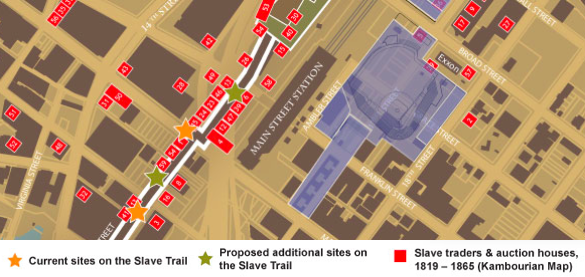Two longer pieces on aspects of the proposed Shockoe redevelopment plan.
[sep]
Urban Scale Richmond looks in-depth at the plan’s impact on the Seventeenth Street Market:
As stated in the Shockoe Economic Revitalization Strategy of 2011, a major goal of the new First Market Square should be “reinforcing Main Street Station’s position as an epicenter driving the culture, creativity and identity” of the Shockoe neighborhood. The market, by incorporating flexible programming, top-notch design values, and ‘round-the-clock scheduling, should be a catalyst for the success of the larger neighborhood. A fully functioning square could underline the kinds of urbane values conducive to the creative entrepreneurship that has already transformed the Shockoe area into a dynamic place to live and work.
[sep]
Archaeologist Terry Brock writes about the archaeological impact of a development in Shockoe:
Instead of discussing who’s right and who’s wrong, I want to discuss the way this debate frames what is historically significant about this space, and how that affects the archaeological resources at the site. I also want to examine whether archaeology will be necessary if this project continues and what archaeological sites may be affected. Finally, I will make a case for a public approach to the mitigation. In this post, I am operating under an assumption that the project, as proposed, will happen. This is not an endorsement, nor is it a critique, of the project: I’m simply asking, “if the project is supported, how will it impact archaeological resources, and what will be or can be done about it?” I have only seen archaeology mentioned a few times, and done so in ways that are either as part of a pro/con argument, or questioning what will happen if archaeological resources exist and are disturbed during the work. Hopefully, I’ll be able to answer some of these questions.


8 comments
Good articles and comments worth consideration by all camps.
Leon Bradby liked this on Facebook.
The first article was long, boring and basically seemed to be an overblown case for putting a bunch of picnic tables where the farmer’s market is today.
The second was one of the more sensible cases I’ve read on a subject that’s been dragged into the discussion by a lot of people who have no experience with archaeology beyond watching Indiana Jones. It’s refreshing to read a balanced exploration of the facts without it being a sales pitch. The author’s point that this is going to happen and folks should be focusing on how to do it well is a point that many would do well to heed. If you care about archaeology, transportation, traffic, whatever, come with solutions.
Fantastic reading. These articles show the richness of good planning and archeology without resorting to name calling. Refreshing and inspiring.
Traffic solution: An exit/entrance from 64 that would go between Evergreen Cemetery and Oakwood Cemetery. Straight into Church Hill, Rocketts Landing, and future Rt-5 development. Believe it would significantly improve traffic flow going through the bottom and allow for future development
Pierce Mac Powell liked this on Facebook.
Looking at the stadium plans I did not see where they would-could build the new Farmers Market building retro to the one originally there in the 1800s or a court yard with statues, etc…? All I see is a walkway from the stadium through that area exiting on Main Street. What is the current status of the Farmers Market proposal?
There was a CHPN link to the same article here from nearly 2-years ago:
http://urbanscalerichmondvirginia.blogspot.com/2012/01/proposal-for-17th-street-market.html
Sorry – wrong link John… here is the correct one:
/2012/01/28/a-proposal-for-the-17th-street-market_21252/